Thoughts after a week with the 2024 MX-5 RF (ND3)
I recently had the privilege to drive a 2024 MX-5 RF (“ND3”) for a week, thanks to Mazda Canada and my local Miata group: Miataphiles of London. It was an interesting opportunity to compare with my (slightly modified) 2016 MX-5 (“ND1”).
Table of Contents
- Specs and Summary
- Non-Generational Cosmetics
- Modified vs Stock
- Soft Top vs Retractable Fastback
- ND1 vs ND2
- ND1 vs ND3
- Infotainment
- ND3 Technology
- Conclusion
Specs and Summary
A brief rundown of the two cars I’m comparing:
| 2016 | 2024 | |
|---|---|---|
| Roof | Soft Top | Retractable Fastback |
| HP | 155 @ 6000 rpm | 181 @ 7000 rpm |
| Torque | 148 lb-ft @ 4600 rpm | 151 @ 4000 rpm |
| Redline | 6800 rpm | 7500 rpm |
| Trim | GS (“Club”) | GT |
| Package | Sport (Brembo, BBS, Recaro, etc) | Grand Sport (Brembo, BBS, leather) |
| Suspension | Koni Sport w/ RoadsterSport springs; Flyin’ Miata Front Sway Bar | Bilstein shocks |
| Exterior | Jet Black Mica | Soul Red Crystal Metallic” |
| Interior | Black w/ Recaro Seats | Sports Tan Nappa Leather |
| Photos |  |
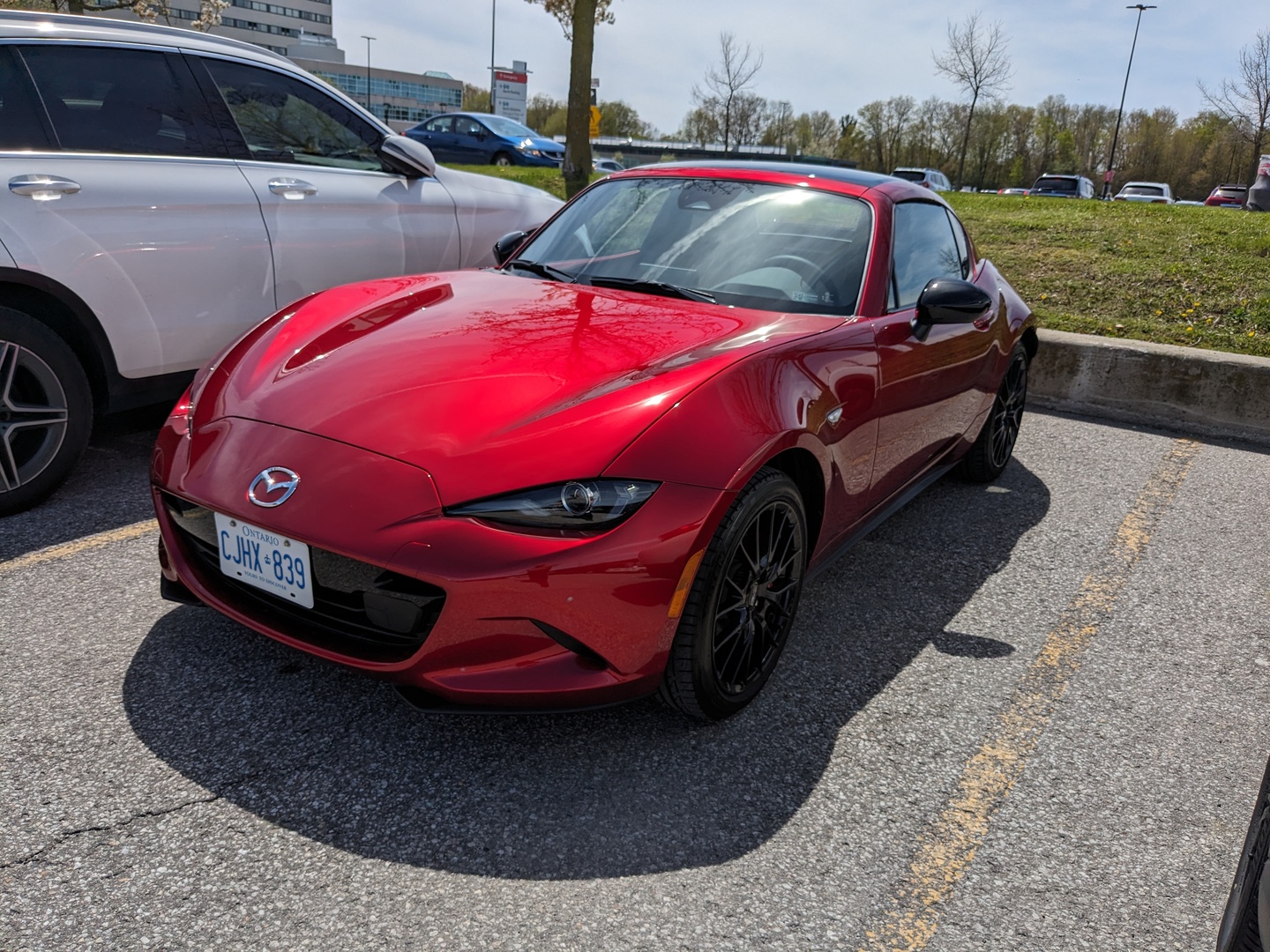 |
Non-Generational Cosmetics
My ND1 is black with black interior, and that unfortunately is the worst colour combo in retrospect. Especially in an MX-5, where the exterior colour wraps around to the interior panels, it’s all just overly monotone. Maybe worst is too strong? Least best? It’s not bad, it’s just… all the other options are better, IMHO.
The ND3 was red with tan interior which is super nice to look at, both inside and outside of the car. Sitting behind the wheel and looking down the hood was great in red. In black, it’s only really cool at night listening to Phil Collins.
I guess this can be solved with a wrap, though.
Leather seats are a preference (and not mine – I prefer cloth seats), but were very comfortable.
Modified vs Stock
I’ve done a few changes to my ND1, swapping out the OEM Bilstein shocks and springs to Koni Sports with RoadsterSport Springs, as well as the Flyin’ Miata Front Sway Bar (but not the rear). These springs in particular are roughly double the spring rate of the stock springs. This has had a few big effects:
- Much rougher on the road. Especially bad roads. Even with the shocks at full soft (which makes it better – but not great). As a driver, I can deal with this, but it’s not great as a passenger.
- It’s lost some of the “slow car fast” feeling. With the stock suspension, the car felt much faster than it actually was, allowing for a lot of fun within the speed limit.
But to offset those points:
- Much more composed on the track. Last Year vs This Year, I was two seconds faster – despite being the first track day after the winter break, on my street tires (Pilot Sport 4S), on a cold damp day. Could I save two seconds on the stock suspension? Sure, probably. But these changes gave me so much more confidence as a starting point.
- I found ND3’s Bilsteins to be a little too bouncy over bumps on rough roads. But that’s better than being crashy like my ND1.
It was nice to be able to A/B compare the two cars (sort of – I obviously didn’t take Mazda’s corporate press car to the track). It also allowed me to compare ride-heights. As measured from the middle of the hub to the wheel arch (to avoid including tires in the figures):
- ND1 Modified: 349mm
- ND3 Stock: 370mm
Note that photos accentuate the wheel arch gap more than it appears in person. Unless you’re 60cm/24” tall, then this is probably how the car looks.
| ND1 | ND3 |
|---|---|
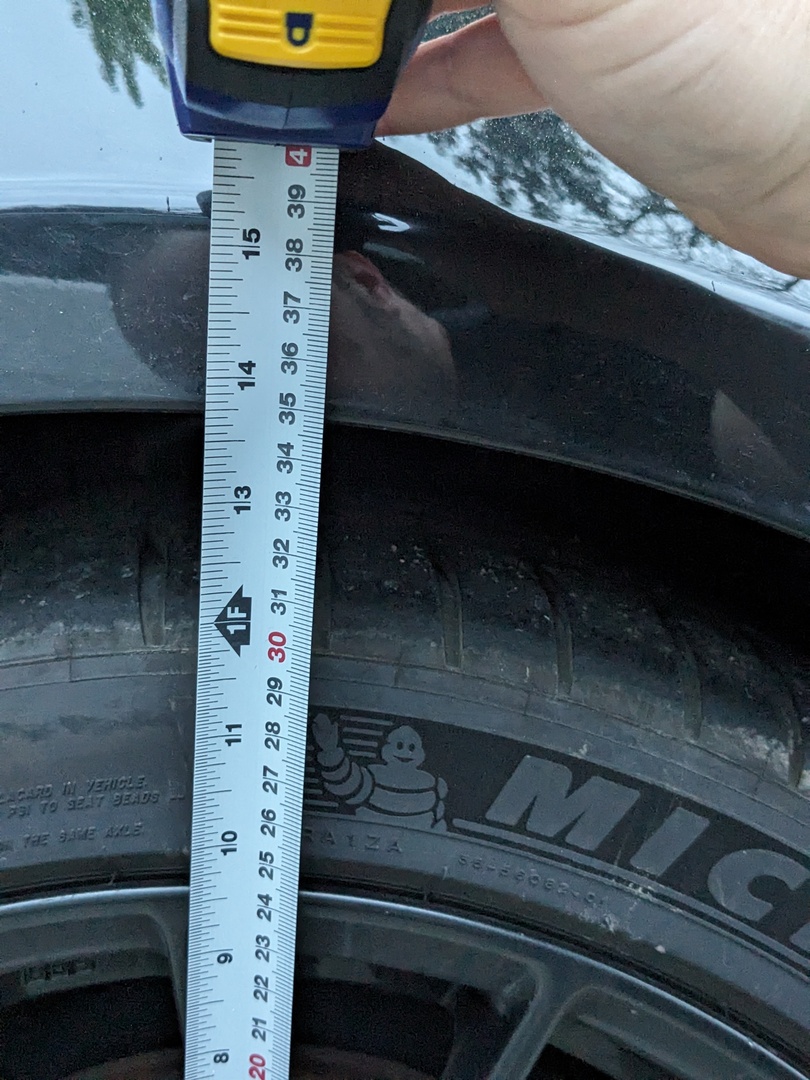 |
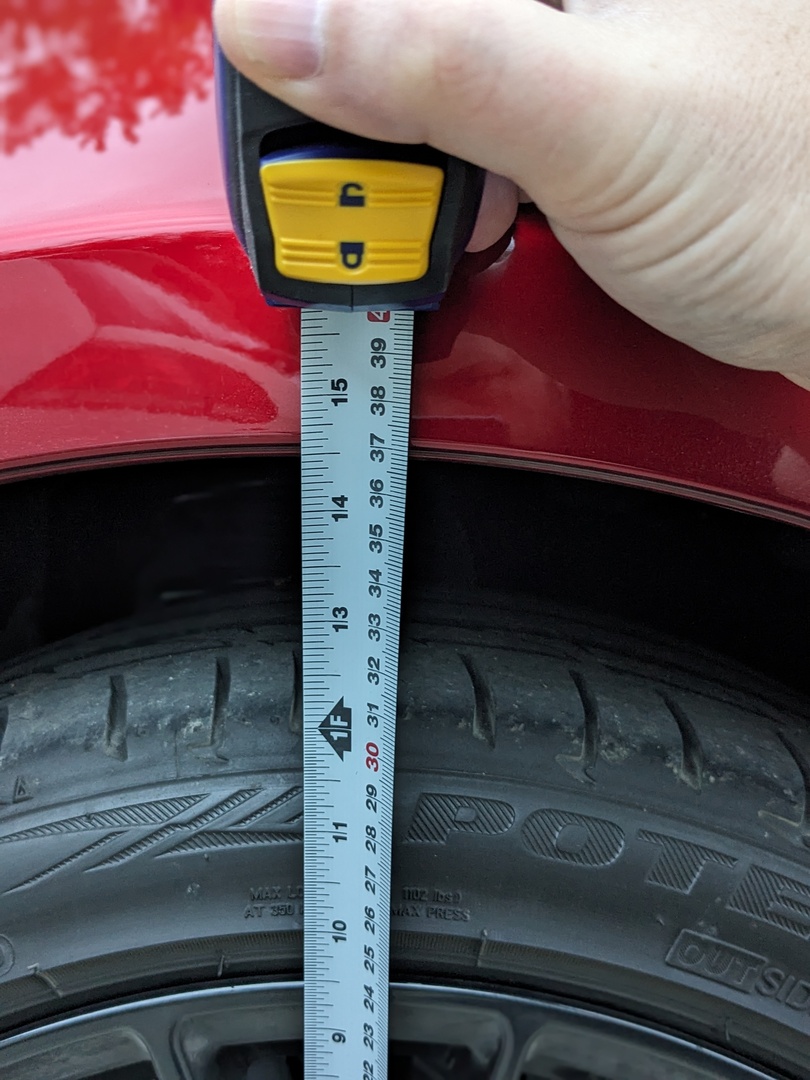 |
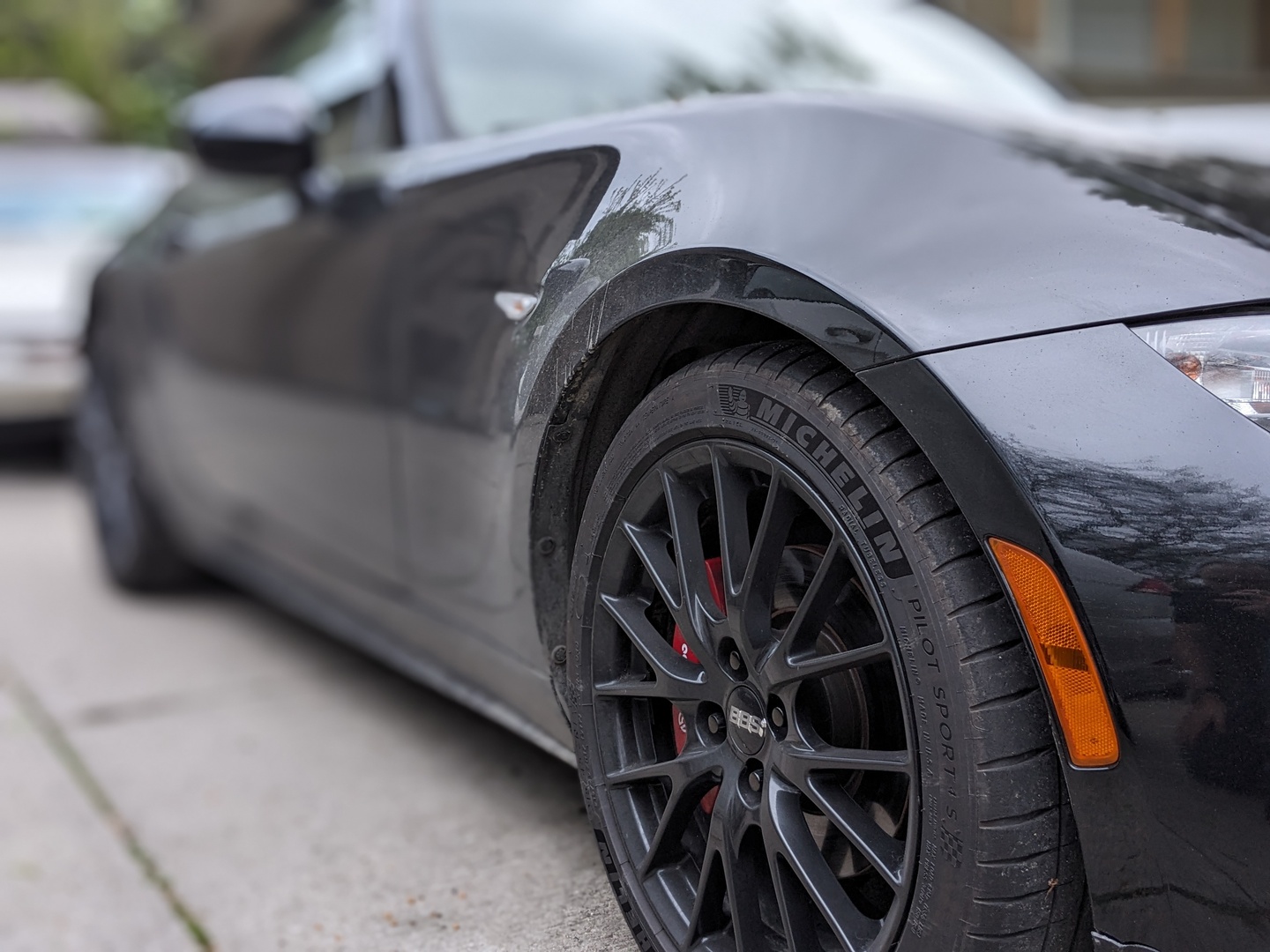 |
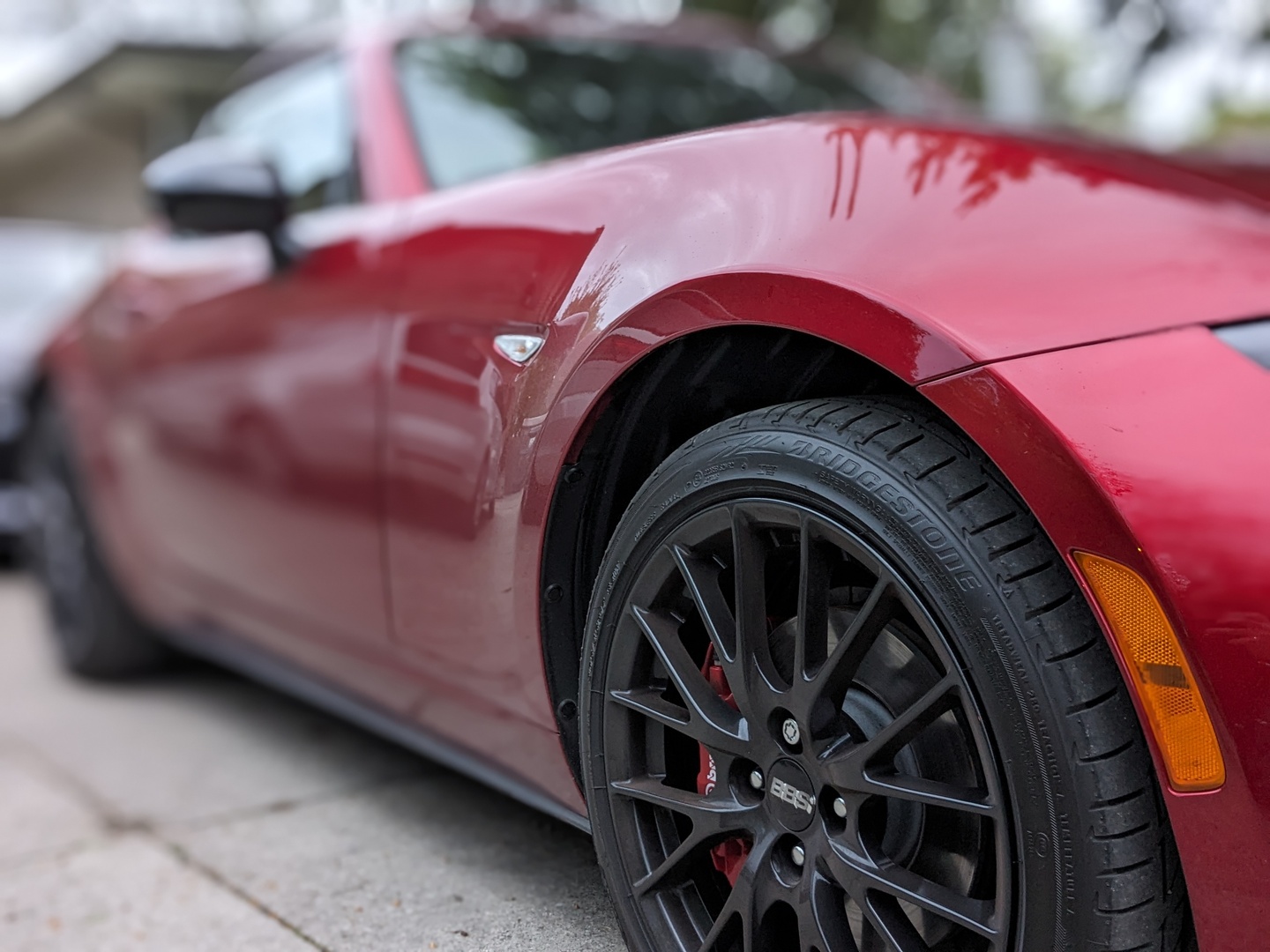 |
Excuse my extremely dirty car in the photos. It rained on the last track day, and I’ve been driving the ND3 all week.
I think for a more track-focused car, I’m still happy with my changes. For a more road-focused car, maybe the Konis paired with the OEM springs (or comparable lowering spring) would be a better combination.
That said, the MX-5 is pretty great right out of the box. So there’s no need to rush in and modify things.
Soft Top vs Retractable Fastback
The RF is not made for me. It sucks, because (and this is entirely subjective) the RF is the better-looking car (at least with the roof up). It’s also the most “car” car, so if this is your only vehicle, or you drive year-round, the RF is probably the better choice.
My first exposure to Miatas was driving my in-laws RF years ago. I loved the car, but I didn’t fit very well. That was true then, and still true now. I’m 185cm/6’1” – tall but not unusually so. However, no matter how I adjust the seat, my head wants be where the RF top is, unless I scooch my head down – which is not comfortable in the long term, and still leaves my head touching the roof.
I found there is a tad more room with the soft-top (and it hurts less on bumps when you hit it), though I had some neck issues a few weeks after getting mine. I finally realized I couldn’t see most stoplights without tilting my head. That problem was finally resolved with an Aurora Auto Design Low Profile Seat Mount. The bracket was a pain to install, hands-down the best QOL improvement I’ve made. I can even fit with my helmet on now. It feels like I’m sitting in the car vs on the car.
I’m worried that with the RF, even with Aurora seat mount, it would still be too tight for me.
Wind Noise was definitely louder in the RF. It didn’t seem to make a big difference on windows down vs up, that just seemed to change where the wind noise was coming from. After some experiments with my hand near the mirror, I was able to significantly reduce wind noise. Some after-market wind foilers would probably be near the top of my mod list, if I owned the RF
That said, I’m speaking as somebody who isn’t overly attached to the concept of the convertible to begin with. I’d be quite happy with a MX-5 Coupé – provided it had sufficient head room – or at least a Gurney Bubble.
ND1 vs ND2
I don’t have a 2019 ND2 on me. However, there are some changes made in that year that persist into 2024, and I felt I should address them.
The higher redline made possible by the revised engine in 2019 is very-much appreciated. In my ND1, I often hit the rev-limiter in first doing hard pulls. Granted, I wasn’t taking the ND3 to the track or autocross, but I was able to time that shift much easier with the 700 RPM available. It sounds silly, but it makes a difference.
I did not notice any performance difference on the street. I don’t know what I was expecting, but it really felt like the same amount of power and torque, it just revs a bit higher. That’s not a bad thing, but on paper, a 17% increase in power sounds more significant than a butt-dyno can detect. Again, I didn’t track the car, so maybe it would make a difference in times, if not feeling.
The telescoping steering column is a huge comfort improvement.
ND1 vs ND3
The LED lights are a nice improvement. I’m not a fan of fake vents, and the MX-5 has some as a result of this change. It will be convenient for those who wish to add brake ducting, though. I understand in Japan you can still option the separate DRLs. Hopefully that’s an option that comes here, too.
The steering seemed lighter – but I never thought the 2016’s steering was particularly heavy, but my project car is a 1988 Pontiac Fiero with a manual steering rack. The steering did seem light, maybe that was “frictionless”, but how much of that was detectable vs placebo, I’m not sure.
I’m not qualified to talk about the revised Differential, I didn’t get to use the new track-mode traction control, and I didn’t feel any effects of G-Vectoring control on the road.
Infotainment
I split this out from the rest of the Technology section because you’ll deal with this daily. The new infotainment is about a million times better.
The screen is brighter and easier to read in the day. It’s better at night. It’s a shorter form factor, so it stays out of your visibility better. It’s just all-around a significant improvement.
The hardware behind it is responsive. I didn’t touch Mazda’s software, instead exclusively using wireless Android Auto. It launched faster, and operated smoother than in my 2016, which is prone to occasional hiccups (and can often take 30 seconds to actually launch AA).
Wireless Android is particularly convenient in this car because there’s nowhere to stash a modern phone. Granted, you can get wireless AA with the older infotainment by buying a $100 AA Wireless Dongle, but now you don’t need a dongle.
That said, running Wireless Android Auto can (and will) destroy your phone battery. But at least when you need to plug in to charge, the ND3 has USB-C ports that put out 20W (9V 2A). The ND1 ports were limited to 10W (5V 2A) (if you had the upgraded Android Auto hub, at least).
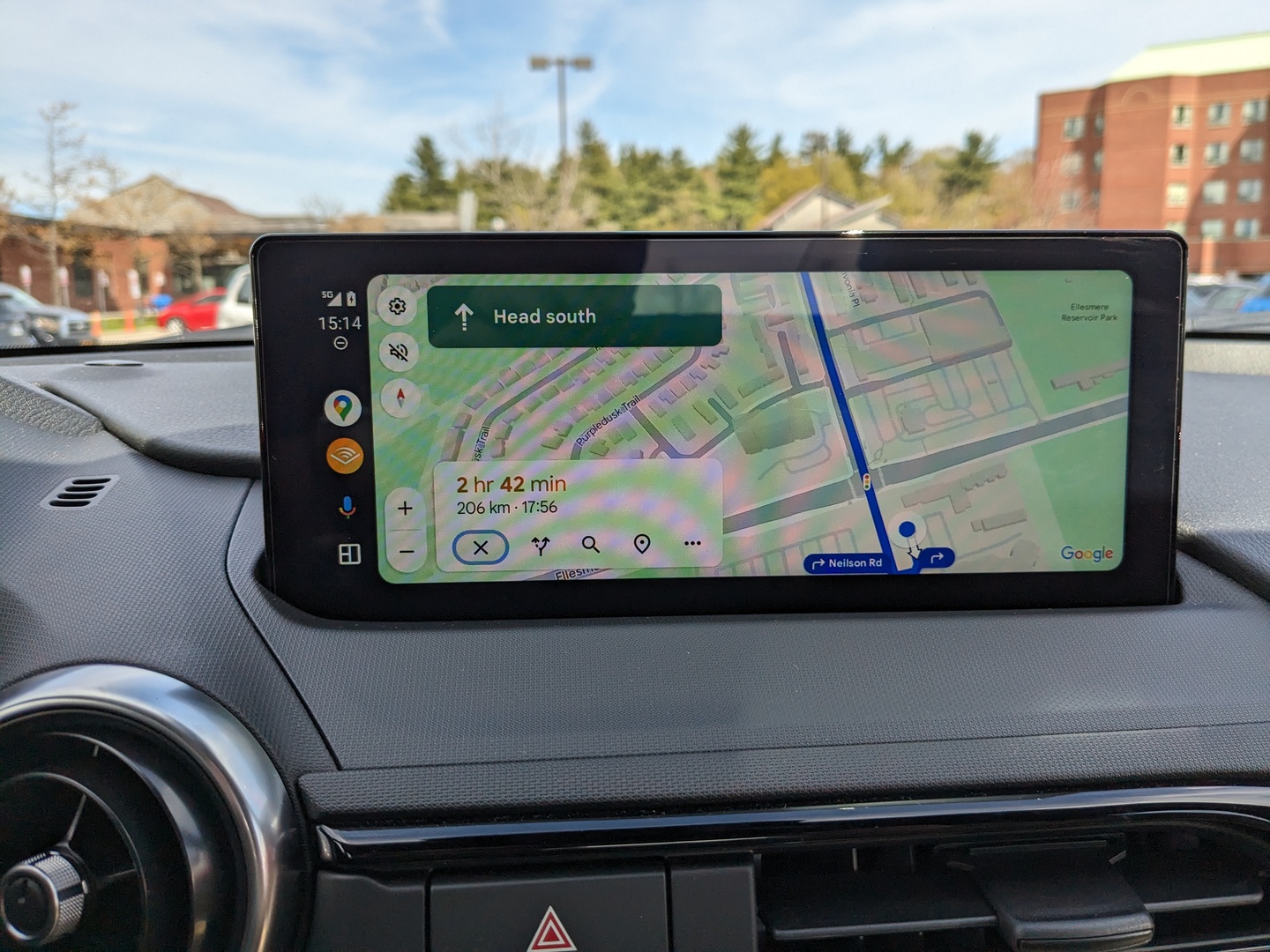
ND3 Technology
The big changes for 2024 are all technology related: All new vehicle electrical platform which allows for the new Infotainment (see above), and new features (automatic high-beams, speed limit detection, radar cruise, etc). All of these features have existed on other cars for years, but are new to both the MX-5 and to myself. I’ve never owned or driven a car with any of these features.
Street sign detection is pretty handy, especially when driving in unfamiliar areas. Apparently this uses a camera, and displays the current speed limit on the dash, as well as allowing a single button-press to set the cruise target to the current speed limit.
This worked rather well, and is much better than incomplete (or worse: outdated) databases from mapping providers. The only caveat is that, obviously, it requires a street sign to be present and visible for it to be read. So you’ll need to be aware what the unposted limit is, which can vary by municipality. That’s a minor detail for such a helpful feature, though. I also never found it giving me the wrong information. It was remarkably good at figuring out when I changed roads, and taking away the speed limit sign until it saw another one.
Automatic high-beams are another feature I’ve never used. It will automatically toggle on/off your high-beams when appropriate. I found this feature to be extremely annoying, as it spasmodically toggled them on/off during a night-time country drive. I think at times it was detecting reflective road signs as oncoming cars. I pulled over during my first night drive specifically to disable this feature and switch back to manual high-beams. Perhaps this can be fixed with software updates to the sensitivity.
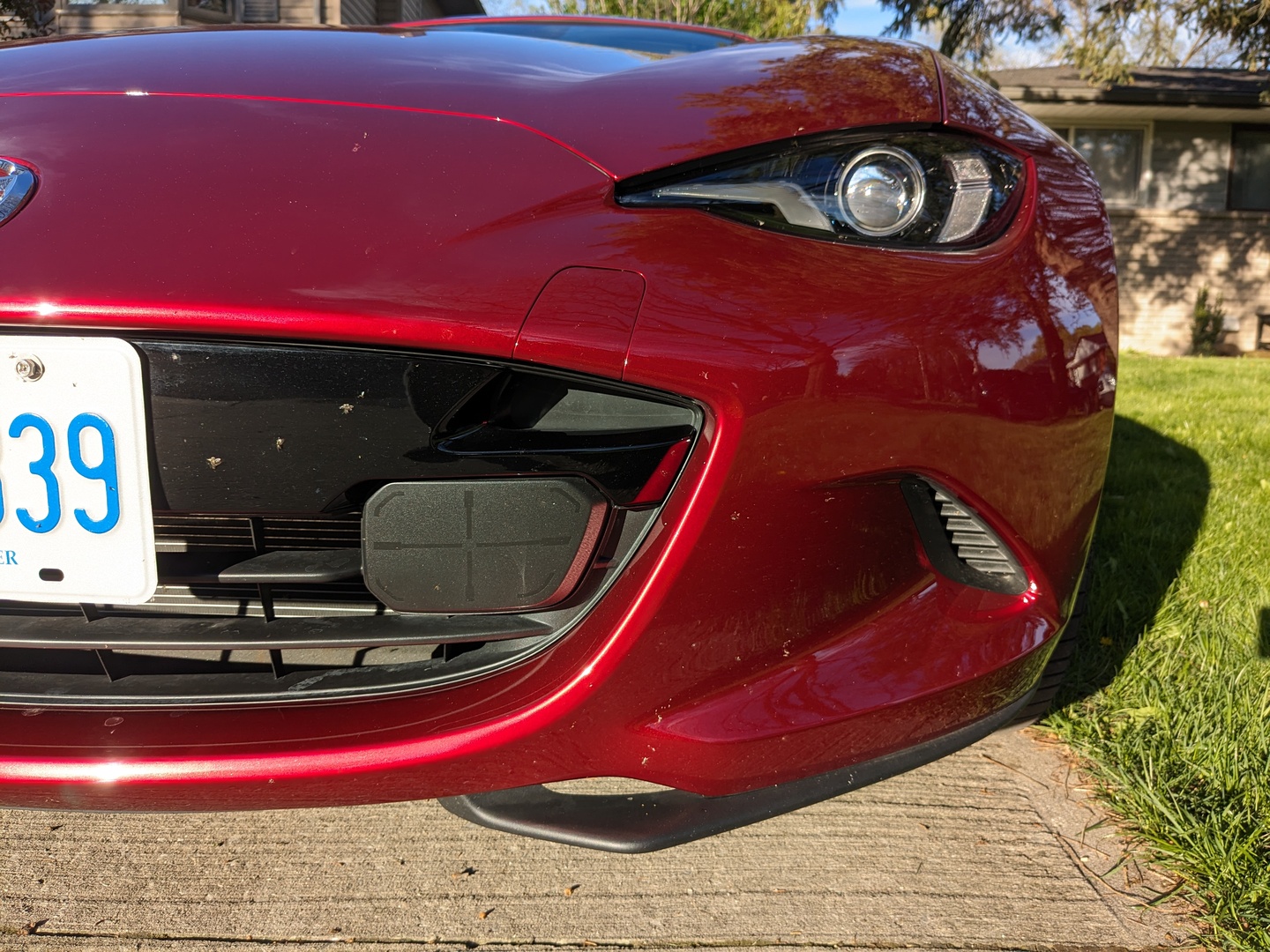
Radar cruise is something I was looking forward to the most, and left me with mixed results that I still haven’t come to a conclusion on. I had to pick up the car in Toronto, and drive 200km back home. I figured the multi-multi-lane 401 was a perfect use-case for Radar cruise. It wasn’t.
I had set a comfortable follow distance to the car in front of me, and things seemed to be going well with minor changes in speed. Then a car merging on from the right wanted to cross through my lane, into the lane to my left, and I wouldn’t need to alter my speed. As a human with driving experience, I knew the intention, though obviously I can forgive a computer for not making that assumption. However, even if I was wrong and the driver stayed in my lane, there was sufficient space that I could just coast-down in-gear to allow some more room. No danger or reason to panic.
However, as soon as the car started entering my lane, the radar cruise hit the brakes somewhat stronger than I expected. I played around with the cruise for a bit more, but wasn’t comfortable with it until I was well out of traffic (about an hour later).
Commuting on provincial highways (traditional country two-lane highways) was a much nicer experience. I still find it was far too happy to speed up to cars and hit the brakes, rather than coasting-down from further away. But it performed as advertised, just not how I’d prefer it to be implemented.
One annoying effect of the cruise being able to control the brakes is that it will actively brake the car if you’re driving over set cruise speed. The best example I have is a large hill on my way home from work. It’s a fairly steep drop to a stream, followed by a hill climb. In any other car with non-radar cruise, the car will happily gain a bit of speed down the hill – which is fine, because it will use it climbing the hill in a few seconds. The ND3, however, will brake the whole way down the hill, just to lay on the gas to get up the hill.
Another example was passing a slow car. Say you have your cruise set to 90km/h, and you come across a car doing 75km/h. You pull out and hammer it to pass, temporarily having your speed in excess of your cruise set speed. As soon as you let off the gas, the car will start braking to get you back down to 90 – instead of letting the car coast down on it’s own.
Now, I don’t expect the car to understand I’d like to preserve momentum on a hill. But I don’t think it’s unreasonable that the car should understand that if I hit the gas to go to a certain speed, I’m comfortable at that speed, and I’m fine letting the car coast down.
Another noteworthy change to cruise behaviour is Cruise doesn’t disengage when you hit the clutch pedal. So you can shift up/down, and the cruise control will continue once you’re in gear. This was very surprising to me, as I expect any clutch/brake press to immediately disable the cruise control.
I can’t say this behaviour is wrong, but it’s very different from any car I’ve driven before. I can’t imagine a scenario where I want to switch gears, but can’t press ‘RES’ to confirm I still want cruise active. That said, I haven’t settled my thoughts on the whole cruise control scenario. It does require driver adjustment, and I find some of it’s behaviours to be outside my comfort zone. But maybe my comfort zone would change after having used it for longer?
Conclusion
My overall impression was how remarkably similar the ND1 is to the ND3 (aside from changes I’ve made). “Well Duh”. The 2024 MX-5 is a great car, but so was the 2023, and the 2022… It would have been very easy for Mazda to change things up. I think the Miata is in a very unique position that changes might actually detract from how great this car is, as-is, straight out of the box – For example, my changes made my car a much worse road car. So I’m not disappointed that it is very similar, but I am surprised and pleased Mazda has such restraint.
If you’re considering buying a newer MX-5, it’s absolutely worth considering for the Infotainment QOL improvements alone. If you just got your 2023 and regret it: It’s really not much different, and I don’t think there’s reason to fret.
If you’re like me, with an older ND, then the upgrade is questionable. I don’t see myself spending money to upgrade from my ND1 to an ND3. If something happened to my ND1, though… A new ND3 would definitely have some bonus points over a used ND1/ND2.

